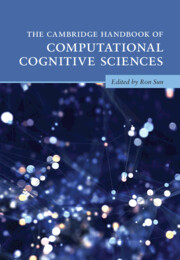Book contents
- The Cambridge Handbook of Computational Cognitive Sciences
- Cambridge Handbooks in Psychology
- The Cambridge Handbook of Computational Cognitive Sciences
- Copyright page
- Contents
- Preface
- Contributors
- Part I Introduction
- Part II Cognitive Modeling Paradigms
- Part III Computational Modeling of Basic Cognitive Functionalities
- Part IV Computational Modeling in Various Cognitive Fields
- Part V General Discussion
- 36 Model Validation, Comparison, and Selection
- 37 Philosophical Issues in Computational Cognitive Sciences
- 38 An Evaluation of Computational Modeling in Cognitive Sciences
- Index
- References
36 - Model Validation, Comparison, and Selection
from Part V - General Discussion
Published online by Cambridge University Press: 21 April 2023
- The Cambridge Handbook of Computational Cognitive Sciences
- Cambridge Handbooks in Psychology
- The Cambridge Handbook of Computational Cognitive Sciences
- Copyright page
- Contents
- Preface
- Contributors
- Part I Introduction
- Part II Cognitive Modeling Paradigms
- Part III Computational Modeling of Basic Cognitive Functionalities
- Part IV Computational Modeling in Various Cognitive Fields
- Part V General Discussion
- 36 Model Validation, Comparison, and Selection
- 37 Philosophical Issues in Computational Cognitive Sciences
- 38 An Evaluation of Computational Modeling in Cognitive Sciences
- Index
- References
Summary
Progress in the computational cognitive sciences depends critically on model evaluation. This chapter provides an accessible description of key considerations and methods important in model evaluation, with special emphasis on evaluation in the forms of validation, comparison, and selection. Major sub-topics include qualitative and quantitative validation, parameter estimation, cross-validation, goodness of fit, and model mimicry. The chapter includes definitions of an assortment of key concepts, relevant equations, and descriptions of best practices and important considerations in the use of these model evaluation methods. The chapter concludes with important high-level considerations regarding emerging directions and opportunities for continuing improvement in model evaluation.
Keywords
- Type
- Chapter
- Information
- The Cambridge Handbook of Computational Cognitive Sciences , pp. 1165 - 1200Publisher: Cambridge University PressPrint publication year: 2023

